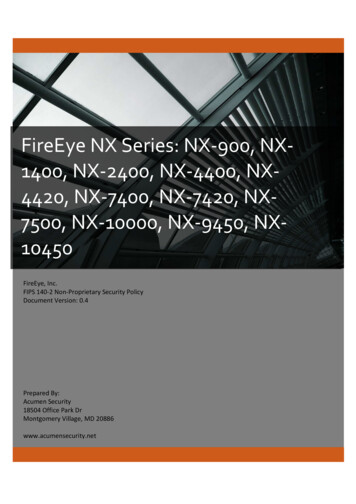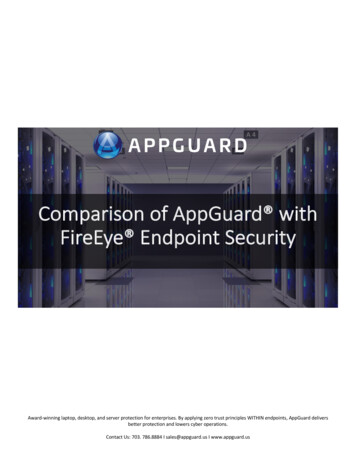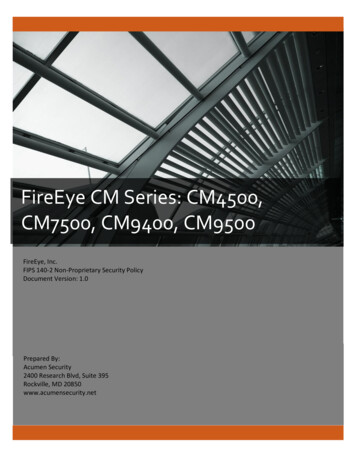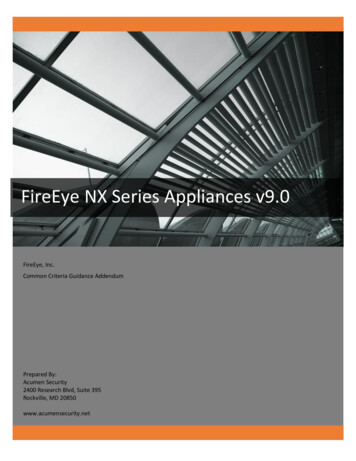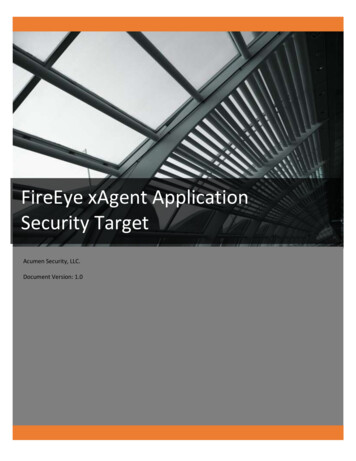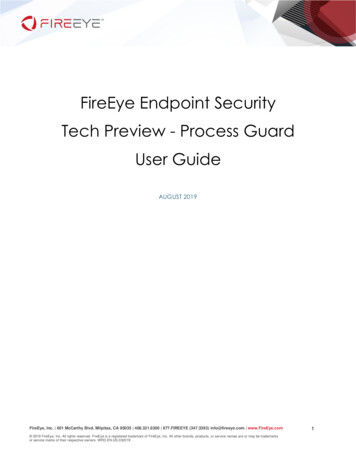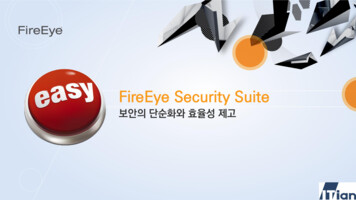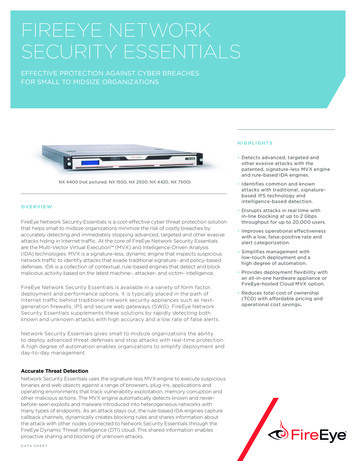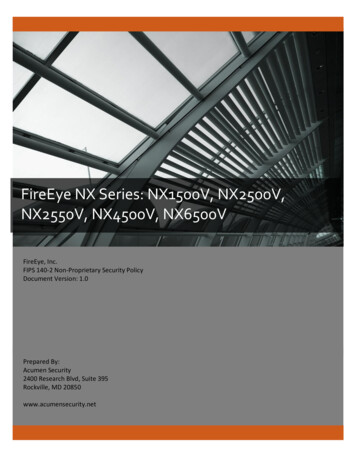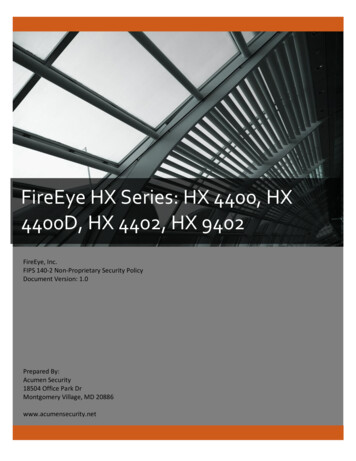
Transcription
FIPS 140-2 Security PolicyFireEye HX Series: HX 4400, HX4400D, HX 4402, HX 9402FireEye, Inc.FIPS 140-2 Non-Proprietary Security PolicyDocument Version: 1.0Prepared By:Acumen Security18504 Office Park DrMontgomery Village, MD 20886www.acumensecurity.netPhone: 1 (703) 375-98201v0.5
FIPS 140-2 Security Policyv1.0Table of Contents1.2.Introduction .41.1Purpose.41.2Document Organization .41.3Notices .4FireEye HX Series: HX 4400, HX 4400D, HX 4402, HX 9402 .52.1Cryptographic Module Specification.62.1.12.2Cryptographic Module Ports and Interfaces .72.3Roles, Services, and Authentication.82.3.1Authorized Roles .82.3.2Authentication Mechanisms .82.3.3Services .92.4Physical Security .132.5Cryptographic Key Management .142.6Cryptographic Algorithm .172.6.1FIPS-approved Algorithms .172.6.2Non-Approved Algorithms Allowed for Use With FIPS-approved services .192.6.3Non-Approved Algorithms .192.7Electromagnetic Interference / Electromagnetic Compatibility (EMI/EMC) .212.8Self-Tests .222.8.1Power-On Self-Tests .222.8.2Conditional Self-Tests .222.8.3Self-Tests Error Handling .222.93.Mitigation of Other Attacks .23Secure Operation .243.1Secure Distribution .243.1.1Firmware Distribution .243.1.2Hardware Distribution .243.2Installation .243.3Initialization .243.3.12Cryptographic Boundary .6Entering New Authentication Credentials .24
FIPS 140-2 Security Policyv1.03.3.2Enable Trusted Platform Module .243.3.3Enable compliance configuration options .243.3.4Enable FIPS 140-2 compliance .253.4Management .253.4.1SSH Usage .253.4.2TLS Usage.263.5Additional Information .26Appendix A: Acronyms .273
FIPS 140-2 Security Policyv1.01. IntroductionThis is a non-proprietary FIPS 140-2 Security Policy for the FireEye HX Series: HX 4400, HX4400D, HX 4402, and HX 9402. Below are the details of the product validated:Hardware Version: HX 4400, HX 4400D, HX 4402, HX 9402Software Version #: 3.1.0FIPS 140-2 Security Level: 11.1PurposeThis document was prepared as Federal Information Processing Standard (FIPS) 140-2validation evidence. The document describes how the FireEye HX Series: HX 4400, HX 4400D,HX 4402, and HX 9402 meets the security requirements of FIPS 140-2. It also providesinstructions to individuals and organizations on how to deploy the product in a secure FIPSapproved mode of operation. Target audience of this document is anyone who wishes to use orintegrate this product into a solution that is meant to comply with FIPS 140-2 requirements.1.2Document OrganizationThe Security Policy document is one document in a FIPS 140-2 Submission Package. In additionto this document, the Submission Package contains: Vendor Evidence documentFinite State MachineOther supporting documentation as additional referencesThis Security Policy and the other validation submission documentation were produced byAcumen Security, LLC. under contract to FireEye, Inc. With the exception of this NonProprietary Security Policy, the FIPS 140-2 Submission Package is proprietary to FireEye, Inc.and is releasable only under appropriate non-disclosure agreements.1.3NoticesThis document may be freely reproduced and distributed in its entirety without modification.4
FIPS 140-2 Security Policyv1.02. FireEye HX Series: HX 4400, HX 4400D, HX 4402, HX 9402The FireEye HX Series: HX 4400, HX 4400D, HX 4402, and HX 9402 (the module) is a multi-chipstandalone module validated at FIPS 140-2 Security Level 1. Specifically, the module meets thefollowing security levels for individual sections in the FIPS 140-2 standard:Table 1 - Security Level for Each FIPS 140-2 Section#12345678910115Section TitleCryptographic Module SpecificationCryptographic Module Ports and InterfacesRoles, Services, and AuthenticationFinite State ModelPhysical SecurityOperational EnvironmentCryptographic Key ManagementEMI/EMCSelf-TestsDesign AssurancesMitigation Of Other AttacksSecurity Level11311N/A1113N/A
FIPS 140-2 Security Policy2.1v1.0Cryptographic Module SpecificationThe FireEye HX series appliances enable security operations teams to correlate network andendpoint activity. Organizations can automatically investigate alerts generated by FireEyeThreat Prevention Platforms, log management, and network security products, applyintelligence from FireEye to continuously validate Indicators of Compromises on the endpointsand identify if a compromise has occurred and assess the potential risk. Further, organizationscan quickly triage the incident to understand the details and contain compromised endpointswith a single click and contain compromised devices within a single click workflow.2.1.1 Cryptographic BoundaryThe cryptographic boundary for the module is defined as encompassing the "top," "front,""left," "right," and "bottom" surfaces of the case and all portions of the "backplane" of the case.The following figures provide a physical depiction of the cryptographic module.Figure 1: FireEye HX 4400/4400D/4402 (top) and 9402 (bottom)6
FIPS 140-2 Security Policy2.2v1.0Cryptographic Module Ports and InterfacesThe module provides a number of physical and logical interfaces to the device, and the physicalinterfaces provided by the module are mapped to four FIPS 140-2 defined logical interfaces:data input, data output, control input, and status output. The logical interfaces and theirmapping are described in the following table:Table 2 - Module Interface Mapping – HX 4400/HX 4400D/HX 4402/HX 9402FIPS InterfaceData InputData OutputControl InputStatus OutputPower Interface7Physical Interface(2x) 10/100/1000 BASE-T Ports (Network Monitoring)(2x) 10/100/1000 BASE-T Ports (Management)PS/2 Keyboard and Mouse Ports(2x) USB PortsSerial Port(2x) 10/100/1000 BASE-T Ports (Network Monitoring)(2x) 10/100/1000 BASE-T Ports (Management)DB15 VGA Port(2x) USB PortsSerial Port(2x) 10/100/1000 BASE-T Ports (Network Monitoring)(2x) 10/100/1000 BASE-T Ports (Management)PS/2 Keyboard and Mouse Ports(2x) USB PortsSerial Port(2x) 10/100/1000 BASE-T Ports (Network Monitoring)(2x) 10/100/1000 BASE-T Ports (Management)DB15 VGA Port(2x) USB PortsSerial PortPower Port
FIPS 140-2 Security Policy2.3v1.0Roles, Services, and AuthenticationThe following sections provide details about roles supported by the module, how these rolesare authenticated and the services the roles are authorized to access.2.3.1 Authorized RolesThe module supports several different roles, including multiple Cryptographic Officer roles anda User role.Configuration of the module can occur over several interfaces and at different levels dependingupon the role assigned to the user. There are multiple types of Cryptographic Officers that mayconfigure the module, as follows: Admin: The system administrator is a “super user” who has all capabilities. The primaryfunction of this role is to configure the system.Monitor: The system monitor has read-only access to some things the admin role canchange or configure.Operator: The system operator has a subset of the capabilities associated with theadmin role. Its primary function is configuring and monitoring the system.Analyst: The system analyst focuses on data plane analysis and possesses severalcapabilities, including setting up alerts and reports.Auditor: The system auditor reviews audit logs and performs forensic analysis to tracehow events occurred.SNMP: The SNMP role provides system monitoring through SNMPv3.The Users of the module are the remote IT devices and remote management clients accessingthe module via cryptographic protocols. These protocols include, SSH, TLS, and SNMPv3.2.3.2 Authentication MechanismsThe module supports identity-based authentication. Module operators must authenticate tothe module before being allowed access to services, which require the assumption of anauthorized role. The module employs the authentication methods described in the table belowto authenticate Crypto-Officers and Users.Unauthenticated users are only able to access the module LEDs and power cycle the module.Table 3 - Authentication Mechanism DetailsRoleAdminMonitorOperatorAnalystAuditor8Type Of AuthenticationPassword/UsernameAuthentication StrengthAll passwords must be between 8 and 32 characters.If (8) integers are used for an eight digit password,the probability of randomly guessing the correctsequence is one (1) in 100,000,000 (this calculation isbased on the assumption that the typical standard
FIPS 140-2 Security PolicyRoleSNMPUserType Of AuthenticationPassword/Username or RSAAsymmetric Authenticationv1.0Authentication StrengthAmerican QWERTY computer keyboard has 10integer digits. The calculation should be 10 8 100,000,000). Therefore, the associated probabilityof a successful random attempt is approximately 1 in100,000,000, which is less than 1 in 1,000,000required by FIPS 140-2. In order to successfully guessthe sequence in one minute would require the abilityto make over 1,666,666 guesses per second, whichfar exceeds the operational capabilities of themodule.All passwords must be between 8 and 32 characters.If (8) integers are used for an eight digit password,the probability of randomly guessing the correctsequence is one (1) in 100,000,000 (this calculation isbased on the assumption that the typical standardAmerican QWERTY computer keyboard has 10integer digits. The calculation should be 10 8 100,000,000). Therefore, the associated probabilityof a successful random attempt is approximately 1 in100,000,000, which is less than 1 in 1,000,000required by FIPS 140-2. In order to successfully guessthe sequence in one minute would require the abilityto make over 1,666,666 guesses per second, whichfar exceeds the operational capabilities of themodule.When using RSA based authentication, RSA key pairhas modulus size of 2048 bit, thus providing 112 bitsof strength. Therefore, an attacker would have a 1 in2 112 chance of randomly obtaining the key, whichis much stronger than the one in a million chancerequired by FIPS 140-2. For RSA-basedauthentication, to exceed a 1 in 100,000 probabilityof a successful random key guess in one minute, anattacker would have to be capable of approximately3.25X10 32 attempts per minute, which far exceedsthe operational capabilities of the modules tosupport.2.3.3 ServicesThe services that are available to unauthenticated entities and the services that requireoperators to assume an authorized role (Crypto-Officer or User) are listed in the table below.9
FIPS 140-2 Security Policyv1.0Please note that the keys and Critical Security Parameters (CSPs) listed below use the followingindicators to show the type of access required: R (Read): The CSP is read W (Write): The CSP is established, generated, or modified Z (Zeroize): The CSP is zeroizedTable 4 - ServicesServiceDescriptionSSH to externalIT deviceSecureconnectionbetween an HXand otherFireEyeappliances usingSSH.UserAdministrativeaccess over SSHSecure remotecommand lineapplianceadministrationover an ministrativeaccess overwebGUISecure remoteGUI applianceadministrationover a RoleKey/CSP and Type of Access DRBG entropy input (R)DRBG Seed (R)DRBG V (R/W/Z)DRBG Key (R/W/Z)Diffie-Hellman Shared Secret (R/W/Z)Diffie Hellman private key (R/W/Z)Diffie Hellman public key (R/W/Z)SSH Private Key (R/W/Z)SSH Public Key (R/W/Z)SSH Session Key (R/W/Z)SSH Integrity Key (R/W/Z)Admin Password (R/W/Z)Monitor Password (R/W/Z)Operator Password (R/W/Z)Analyst Password (R/W/Z)Auditor Password (R/W/Z)DRBG entropy input (R)DRBG Seed (R)DRBG V (R/W/Z)DRBG Key (R/W/Z)Diffie-Hellman Shared Secret (R/W/Z)Diffie Hellman private key (R/W/Z)Diffie Hellman public key (R/W/Z)SSH Private Key (R/W/Z)SSH Public Key (R/W/Z)SSH Session Key (R/W/Z)SSH Integrity Key (R/W/Z)Admin Password (R/W/Z)Monitor Password (R/W/Z)Operator Password (R/W/Z)Analyst Password (R/W/Z)Auditor Password (R/W/Z)DRBG entropy input (R)DRBG Seed (R)DRBG V (R/W/Z)
FIPS 140-2 Security PolicyServiceAdministrativeaccess overserial consoleand VGASNMPv3LDAP over TLSSecure ommand lineapplianceadministration.Secure remoteSNMPv3-basedsystemmonitoring.Secure remoteauthenticationvia TLS rSNMPTLS-basedconnection witha remote auditserver.UserUserKey/CSP and Type of Access DRBG Key (R/W/Z)Diffie-Hellman Shared Secret (R/W/Z)Diffie Hellman private key (R/W/Z)Diffie Hellman public key (R/W/Z)TLS Private Key (R/W/Z)TLS Public Key (R/W/Z)TLS Pre-Master Secret (R/W/Z)TLS Session Encryption Key (R/W/Z)Admin Password (R/W/Z)Monitor Password (R/W/Z)Operator Password (R/W/Z)Analyst Password (R/W/Z)Auditor Password (R/W/Z) SNMP Session Key (R/W/Z)SNMPv3 password (R/W/Z) Admin Password (R/W/Z)Monitor Password (R/W/Z)Operator Password (R/W/Z)Analyst Password (R/W/Z)Auditor Password (R/W/Z)DRBG entropy input (R)DRBG Seed (R)DRBG V (R/W/Z)DRBG Key (R/W/Z)Diffie-Hellman Shared Secret (R/W/Z)Diffie Hellman private key (R/W/Z)Diffie Hellman public key (R/W/Z)TLS Private Key (R/W/Z)TLS Public Key (R/W/Z)TLS Pre-Master Secret (R/W/Z)TLS Session Encryption Key (R/W/Z)DRBG entropy input (R)DRBG Seed (R)DRBG V (R/W/Z)DRBG Key (R/W/Z)Diffie-Hellman Shared Secret (R/W/Z)Diffie Hellman private key (R/W/Z)Diffie Hellman public key (R/W/Z)TLS Private Key (R/W/Z)TLS Public Key (R/W/Z)
FIPS 140-2 Security PolicyServiceLoad FirmwareDescriptionv1.0RoleLoad newfirmware imagePerformzeroization of allpersistent CSPswithin themoduleAdminShow StatusView theoperationalstatus of themoduleStatus LEDOutputView status viathe ModulesLEDs.Reboot Un-authZeroization via“compliancedeclassifyzeroize”CommandCycle Power/Perform SelfTestsR – Read, W – Write, Z – or,Un-authKey/CSP and Type of Access TLS Pre-Master Secret (R/W/Z)TLS Session Encryption Key (R/W/Z)Firmware Load public key (R/W/Z) Admin Password (Z)Monitor Password (Z)Operator Password (Z)Analyst Password (Z)Auditor Password (Z)SSH Private Key (Z)SSH Public Key (Z)SNMPv3 password (Z)TLS Private Key (Z)TLS Public Key (Z)N/A N/A DRBG entropy input (Z)DRBG Seed (Z)DRBG V (Z)DRBG Key (Z)Diffie-Hellman Shared Secret (Z)Diffie Hellman private key (Z)Diffie Hellman public key (Z)SSH Session Key (Z)SSH Integrity Key (Z)SNMPv3 session key (Z)TLS Pre-Master Secret (Z)TLS Session Encryption Key (Z)TLS Session Integrity Key (Z)
FIPS 140-2 Security Policy2.4Physical SecurityThe modules are production grade multi-chip standalone cryptographic modules that meetLevel 1 physical security requirements.13v1.0
FIPS 140-2 Security Policy2.5v0.5Cryptographic Key ManagementThe following table identifies each of the CSPs associated with the module. For each CSP, the following information is provided: The name of the CSP/Key The type of CSP and associated length A description of the CSP/Key Storage of the CSP/Key The zeroization for the CSP/KeyTable 5 - Details of Cryptographic Keys and CSPsKey/CSPDRBG entropyinputDRBG SeedTypeCTR 256-bitDescriptionThis is the entropy for SP 800-90 RNG.StorageZeroizationDRAMDevice power cycle.CTR 256-bitDRAMDevice power cycle.DRBG VCTR 256-bitDRAMDevice power cycle.DRBG KeyCTR 256-bitDRAMDevice power cycle.Diffie-HellmanShared SecretDiffie Hellmanprivate keyDiffie Hellmanpublic keySSH Private KeyDH 2048 – 3072bitsDH 2048 – 3072bitsDH 2048 – 3072bitsRSA (Private Key)2048 – 3072 bitsRSA (Public Key)2048 – 3072 bitsTriple-DES 192bitsThis DRBG seed is collected from the onboard hardwareentropy source.Internal V value used as part of SP800-90 CTR DRBG.Internal Key value used as part of SP800-90 CTR DRBG.The shared exponent used in Diffie-Hellman (DH)exchange. Created per the Diffie-Hellman protocol.The private exponent used in Diffie-Hellman (DH)exchange.The p used in Diffie-Hellman (DH) exchange.DRAMDevice power cycle.DRAMDevice power cycle.DRAMDevice power cycle.The SSH private key for the module used for sessionauthentication.The SSH public key for the module used for sessionauthentication.The SSH session key. This key is created through SSHkey establishment.NVRAMOverwritten w/ “00”prior to replacement.Overwritten w/ “00”prior to replacement.Device power cycle.SSH Public KeySSH Session Key14NVRAMDRAM
FIPS 140-2 Security PolicyKey/CSPSSH Integrity KeySNMPv3 passwordSNMPv3 sessionkeyTLS Private KeyTLS Public KeyTLS Pre-MasterSecretTLS SessionEncryption KeyTLS SessionIntegrity KeyFirmware LoadPublic KeyAdmin Password15TypeAES 128, 256 bitsHMAC-SHA1,HMAC-SHA-256HMAC-512Shared Secret, atleast eightcharactersAES 128 bitsv1.0DescriptionStorageZeroizationThe SSH data integrity key. This key is created throughSSH key establishment.DRAMDevice power cycle.This secret is used to derive HMAC-SHA1 key forSNMPv3 Authentication.NVRAMOverwritten w/ “00”prior to replacement.SNMP symmetric encryption key used toencrypt/decrypt SNMP traffic.This private key is used for TLS session authentication.DRAMDevice power cycle.NVRAMOverwritten w/ “00”prior to replacement.This public key is used for TLS session authentication.NVRAMOverwritten w/ “00”prior to replacement.Shared Secret created using asymmetric cryptographyfrom which new TLS session keys can be created.Key used to encrypt/decrypt TLS session data.DRAMDevice power cycle.DRAMDevice power cycle.HMAC SHA-1 160 HMAC-SHA-1 used for TLS data integrity protection.bitsRSA 2048-bitRSA key used to validate the integrity of a downloadedfirmware image.Shared Secret,Authentication password for the Admin user role.DRAMDevice power cycle.NVRAMOverwritten w/ “00”prior to replacement.Overwritten w/ “00”RSA (Private Key)2048 – 3072 bitsECDSA ( P-256 P384 P-521)RSA (Private Key)2048 – 3072 bitsECDSA (P-256 P384 P-521)Shared Secret,384 bitsTriple-DES 192bitsAES 128, 256 bitsNVRAM
FIPS 140-2 Security PolicyKey/CSPMonitor PasswordOperator PasswordAnalyst PasswordAuditor Password16Type8 charactersShared Secret,8 charactersShared Secret,8 charactersShared Secret,8 charactersShared Secret,8 charactersv1.0DescriptionStorageAuthentication password for the Monitor user role.NVRAMAuthentication password for the Operator user role.NVRAMAuthentication password for the Analyst user role.NVRAMAuthentication password for the Audit user role.NVRAMZeroizationprior to replacement.Overwritten w/ “00”prior to replacement.Overwritten w/ “00”prior to replacement.Overwritten w/ “00”prior to replacement.Overwritten w/ “00”prior to replacement.
FIPS 140-2 Security Policy2.6v0.5Cryptographic Algorithm2.6.1 FIPS-approved AlgorithmsThe following table identifies the FIPS-approved algorithms included in the module for use inthe FIPS mode of operation.Table 6 – FIPS-approved AlgorithmsCryptographic AlgorithmTriple-DESCAVPCert. #1941UsageUsed for encryption of SSH andTLS sessions.TECB(KO 1 e/d, KO 2 d only);TCBC(KO 1 e/d, KO 2 d only);TCFB1(KO 1 e/d, KO 2 d only); (CAVPtested but not used by the module)TCFB8(KO 1 e/d, KO 2 d only); (CAVPtested but not used by the module)TCFB64(KO 1 e/d, KO 2 d only); (CAVPtested but not used by the module)TOFB(KO 1 e/d, KO 2 d only) (CAVP testedbut not used by the module)AES3447ECB (e/d; 128, 192, 256);CBC (e/d; 128, 192, 256);GCM (AES 128(e/d), AES 256(e/d));GCM (AES 192(e/d)); (CAVP tested butnot used by the module)CFB1 (e/d; 128, 192, 256); (CAVP testedbut not used by the module)CFB8 (e/d; 128, 192, 256); (CAVP testedbut not used by the module)OFB (e/d; 128, 192, 256); (CAVP testedbut not used by the module)CCM (KS: 128, 192, 256) (CAVP tested butnot used by the 7Used for encryption of SSH,SNMP, and TLS sessions. Used insupport of FIPS-approved DRBG.Note: The module use of AESGCM complies with theGuidelines for the Selection,Configuration, and Use ofTransport Layer Security (TLS)Implementations defined in SP800-52.2195Used for SSH and TLS trafficintegrity. Used in support of SSH,SNMP, and TLS key derivation.
FIPS 140-2 Security -256;SHA-384;SHA-512RSA18v1.02837,2836Used for SSH, SNMP, and TLStraffic integrity. Used in supportof SSH, SNMP, and TLS keyderivation.Firmware load test.1759,1758Used for SSH and TLS Sessionauthentication.Firmware load test.FIPS186-4:186-4 KEY(gen);ANSIX9.31 Sig(Gen): (2048 SHA(256, 384,512)) (3072 SHA(256, 384, 512));ANSIX9.31 Sig(Ver): (2048 SHA(1, 256,384, 512)) (3072 SHA(1, 256, 384, 512));ANSIX9.31 Sig(Ver): (1024 SHA(1, 256,384, 512)); (CAVP tested but not used bythe module)RSASSA-PKCS1 V1 5: SIG(gen) (2048SHA(256, 384, 512)) (3072 SHA(256, 384,512));RSASSA-PKCS1 V1 5: SIG(Ver) (2048SHA(1, 224, 256, 384, 512)) (3072 SHA(1,224, 256, 384, 512))RSASSA-PKCS1 V1 5: SIG(Ver) (1024SHA(1, 224, 256, 384, 512)) (CAVP testedbut not used by the module)ECDSA696FIPS186-4:PKG: CURVES(P-256 P-384 P-521ExtraRandomBits TestingCandidates)PKV: CURVES(P-256 P-384 P-521)SigGen: CURVES(P-256: (SHA-224, 256,384, 512) P-384: (SHA-224, 256, 384, 512)P-521: (SHA-224, 256, 384, 512)SigVer: CURVES(P-256: (SHA-1, 224, 256,384, 512) P-384: (SHA-1, 224, 256, 384,512) P-521: (SHA-1, 224, 256, 384, 512))DRBGUsed for TLS Sessionauthentication. Supported curvesinclude, P-256 P-384 P-521.843Used in support of SSH and TLSsessions. Used to seed RSA key
FIPS 140-2 Security Policyv1.0CTR DRBGCVL533TLS;SSH;SNMP;FFC Ephem: (KARole: Initiator/responder)generation.SSH, TLS, and SNMP KeyDerivation.Note: The TLS, SSH, and SNMPprotocols have not been reviewed ortested by the CAVP and CMVP.2.6.2 Non-Approved Algorithms Allowed for Use With FIPS-approved servicesThe module implements the following non-Approved algorithms that are allowed for use withFIPS-approved services: Diffie-Hellman – CVL Cert. #533, provides 112 or 128-bits of encryption strength. DiffieHellman with less than 112-bits of security strength is non-compliant and may not beused. Elliptic Curve Diffie-Hellman – provides between 128 and 256-bits of encryptionstrength. Supported curves, include, P-256 P-384 P-521. RSA Key Wrapping – provides 112 or 128 bits of encryption strength. RSA with less than112-bits of security strength is non-compliant and may not be used. Non-approved NDRNG for seeding the DRBG.2.6.3 Non-Approved AlgorithmsThe cryptographic module implements the following non-approved algorithms that are notpermitted for use in FIPS 140-2 mode of operations:Table 7 – Non-Approved AlgorithmsServiceSSH*TLS*SNMP*19Non-Approved AlgorithmHashing: MD5,MACing: HMAC MD5Symmetric: DESAsymmetric: 1024-bit RSA, 1024-bit Diffie-HellmanHashing: MD5,MACing: HMAC MD5Symmetric: DES, RC4Asymmetric: 1024-bit RSA, 1024-bit Diffie-HellmanHashing: MD5,MACing: HMAC MD5Symmetric: DES, RC4Asymmetric: 1024-bit RSA, 1024-bit Diffie-Hellman
FIPS 140-2 Security PolicyNote: Services marked with a single asterisk (*) may use non-compliant cryptographicalgorithms. Use of these algorithms are prohibited in a FIPS-approved mode of operation.20v1.0
FIPS 140-2 Security Policy2.7v1.0Electromagnetic Interference / Electromagnetic Compatibility (EMI/EMC)All HX appliances are FCC (Part 15 Class-A), CE (Class-A), CNS, AS/NZS, VCCI (Class A) certified.21
FIPS 140-2 Security Policy2.8v1.0Self-TestsSelf-tests are health checks that ensure that the cryptographic algorithms within the moduleare operating correctly. The self-tests identified in FIPS 140-2 broadly fall within two categories Power-On Self-Tests Conditional Self-Tests2.8.1 Power-On Self-TestsThe cryptographic module performs the following self-tests at Power-On: Software integrity (SHA-256) HMAC-SHA1 Known Answer Test HMAC-SHA224 Known Answer Test HMAC-SHA256 Known Answer Test HMAC-SHA384 Known Answer Test HMAC-SHA512 Known Answer Test AES-128 ECB Encrypt Known Answer Test AES-128 ECB Decrypt Known Answer Test AES-GCM-256 Encrypt Known Answer Test AES-GCM-256 Decrypt Known Answer Test Triple-DES Encrypt Known Answer Test Triple-DES Decrypt Known Answer Test RSA Known Answer Test ECDSA Known Answer Test DRBG Known Answer Test2.8.2 Conditional Self-TestsThe cryptographic module performs the following conditional self-tests: Continuous Random Number Generator Test (CRNGT) for FIPS-approved DRBG Continuous Random Number Generator (CRNGT) for Entropy Source Firmware Load Test (2048-bit RSA, SHA-256) Pairwise Consistency Test (PWCT) for RSA Pairwise Consistency Test (PWCT) for ECDSA2.8.3 Self-Tests Error HandlingIf any of the identified POSTs fail, the module will not enter an operational state and willinstead provide an error message and reboot. If either of the CRNGTs fail, the repeated randomnumbers are discarded and another random number is requested. If either of the PWCTs fail,the key pair or signature is discarded and another key pair or signature is generated. If theFirmware Load Test fails, the new firmware is not loaded.Both during execution of the self-tests and while in an error state, data output is inhibited.22
FIPS 140-2 Security Policy2.9v1.0Mitigation of Other AttacksThe module does not claim to mitigate any other attacks beyond those specified in FIPS 140.23
FIPS 140-2 Security Policyv1.03. Secure OperationThe following steps are required to put the module into a FIPS-approved mode of operation.3.1Secure DistributionThe following activities ensure secure distribution and delivery of the module:3.1.1 Firmware DistributionThe module firmware is distributed via secure download from FireEye. When newlydownloaded firmware is loaded, the module performs a firmware load test verifying theintegrity of the image.3.1.2 Hardware DistributionThe module hardware is shipped in sealed boxes. This boxes will indicate any tampering duringthe delivery process. Upon delivery, the recipient must inspect the package the module isdelivered in to verify that there has been no tampering.3.2InstallationThere are no FIPS 140 specific hardware installation steps required.3.3Initialization3.3.1 Entering New Authentication CredentialsThe initial power on of the appliance, the CO will be prompted create a new “Admin”administrator with authentication credentials.3.3.2 Enable Trusted Platform ModuleEnable the on board TPM which is used as an entropy source for the implemented FIPSapproved DRBG.1. Enter the CLI configuration mode:hostname enablehostname # configure terminal2. Check if the TPM is present and enabled.hostname (config) # show tpm3. Enable the TPM:hostname (config) # tpm enable4. After reading the warning, select yes to co
FireEye, Inc. FIPS 140-2 Non-Proprietary Security Policy Document Version: 1.0 Prepared By: Acumen Security 18504 Office Park Dr Montgomery Village, MD 20886 www.acumensecurity.net Phone: 1 (703) 375-9820 FireEye HX Series: HX 4400, HX 4400D, HX 4402, HX 9402
